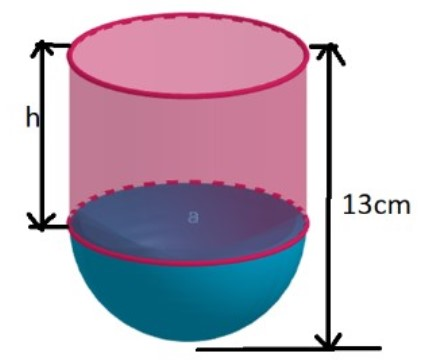
A vessel in the form of a hollow hemisphere mounted by a hollow cylinder. The diameter of the hemispherical portion of the vessel is 14cm, and the total height of the vessel is 13cm. Find the inner surface area of the vessel.
[a] 557 square centimetres
[b] 517 square centimetres
[c] 537 square centimetres
[d] 572 square centimetres
Answer
415.3k+ views
Hint: Assume that the height of the cylindrical part is h. Observe that the total height of the object is the sum of the height of the cylinder and the radius of the hemisphere. Hence determine the height of the cylinder. Use the fact that the curved surface area of a cylinder $=\pi {{r}^{2}}h$ and the curved surface area of the hemisphere $=2\pi {{r}^{2}}$. Hence determine the inner surface area of the vessel.
Complete step-by-step answer:

We have the diameter of the hemisphere = 14cm.
Hence the radius of the hemisphere $=\dfrac{14}{2}=7cm$.
Hence the radius of the hemisphere = 7cm
Let the height of the cylinder be h. As is evident from the diagram above, the height of the vessel is the sum of the height of the cylinder and radius of the hemisphere.
Hence, we have
h+7 = 13
Subtracting 7 from both sides, we get
h = 6
Hence the height of the cylinder = 6cm.
Now, we know that the curved surface area of a cylinder $=\pi {{r}^{2}}h$ and the curved surface area of the hemisphere $=2\pi {{r}^{2}}$
Hence, the inner surface area of the vessel $=\pi {{r}^{2}}+2\pi rh=2\pi r\left( h+r \right)=2\times \dfrac{22}{7}\times 7\times \left( 6+7 \right)=572$
Hence, the inner surface area of the vessel = $572cm^{2}$.
Hence option [d] is correct.
Note: In the above question, students usually make a mistake in taking the height of the cylinder. The height of the cylinder, in this case, is not equal to the height of the vessel.The total height of the object is the sum of the height of the cylinder and the radius of the hemisphere.
Complete step-by-step answer:

We have the diameter of the hemisphere = 14cm.
Hence the radius of the hemisphere $=\dfrac{14}{2}=7cm$.
Hence the radius of the hemisphere = 7cm
Let the height of the cylinder be h. As is evident from the diagram above, the height of the vessel is the sum of the height of the cylinder and radius of the hemisphere.
Hence, we have
h+7 = 13
Subtracting 7 from both sides, we get
h = 6
Hence the height of the cylinder = 6cm.
Now, we know that the curved surface area of a cylinder $=\pi {{r}^{2}}h$ and the curved surface area of the hemisphere $=2\pi {{r}^{2}}$
Hence, the inner surface area of the vessel $=\pi {{r}^{2}}+2\pi rh=2\pi r\left( h+r \right)=2\times \dfrac{22}{7}\times 7\times \left( 6+7 \right)=572$
Hence, the inner surface area of the vessel = $572cm^{2}$.
Hence option [d] is correct.
Note: In the above question, students usually make a mistake in taking the height of the cylinder. The height of the cylinder, in this case, is not equal to the height of the vessel.The total height of the object is the sum of the height of the cylinder and the radius of the hemisphere.
Recently Updated Pages
Master Class 9 General Knowledge: Engaging Questions & Answers for Success

Master Class 9 English: Engaging Questions & Answers for Success

Master Class 9 Science: Engaging Questions & Answers for Success

Master Class 9 Social Science: Engaging Questions & Answers for Success

Master Class 9 Maths: Engaging Questions & Answers for Success

Class 9 Question and Answer - Your Ultimate Solutions Guide

Trending doubts
According to Bernoullis equation the expression which class 11 physics CBSE

A solution of a substance X is used for white washing class 11 chemistry CBSE

10 examples of friction in our daily life

Simon Commission came to India in A 1927 B 1928 C 1929 class 11 social science CBSE

Difference Between Prokaryotic Cells and Eukaryotic Cells

Can anyone list 10 advantages and disadvantages of friction




